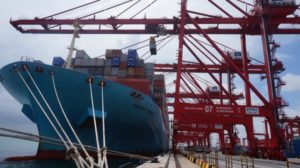Ahead of the Maersk Group 2016 annual report due today, analyst Jefferies has predicted a substantial recovery for the group’s container division for this year.
In a note to investors Jefferies said it expected that the Maersk Group’s 2017 NOPAT (net operating profit after tax) would recover to $2.6bn, which compares to the company’s “below $1bn” outlook for 2016.
The improvement follows “a sea change in strategy and market fundamentals” at the Danish group said Jefferies, and was “driven by a recovery at Maersk Line”.
Jefferies said it is “assuming a 10% higher freight rate, based on a 20% higher contract rate and a stable spot rate” which it suggested could potentially give Maersk Line a full-year NOPAT of $1.7bn.
If Jefferies is correct in its predictions this would be a massive swing in profitability for the container division, which lost $116m in the third quarter of 2016, resulting in a cumulative nine-month loss of $230m. This compared to a profit of $1.5bn recorded at the same stage of 2015.
For the final quarter of 2016 Jefferies expects Maersk Line to post a modest profit of $35m, driven by higher spot rates, “but partly offset by low 2016 contract rates”.
OOCL started the results ball rolling last week with the release of its fourth-quarter operational results, showing a year-on-year 10.3% increase in revenue, albeit earned from 20.2% more container liftings. But it will be Maersk that will kick-off the annual reporting season proper this week.
Investors and analysts will arguably be more interested in chief executive Soren Skou’s expectations for its liner division this year, rather than the result for the full-year 2016, which has already been written off as a disaster for liner shipping.
Indeed, 2016 is likely to have been one of the worst years in history of the industry with billions of dollars of losses racked up by ocean carriers in the 12 month period, and not least the bankruptcy of Hanjin and the enforced consolidation of the sector.
Drewry said last month that it expected contract rates to rise by between 12% and 14% on the main east-west trades.
However, it also gave a chilling warning to shippers that in “worst case scenarios” contract rates could jump by a massive 40% this year.
Elsewhere, Patrik Berglund, chief executive of container freight pricing platform Xeneta, warned shippers that adopting a wait-and-see strategy was “a big risk” this year, given the underlying fundamentals.
Referring to reports that long-term rate negotiations had been stalled until after the Chinese New Year (CNY) when the market is traditionally softer, he said, “I’ve got to stress that this is a risk, because, if the rate increase related to the CNY stays, then shippers will be worse off.”
Last week the Shanghai Containerized Freight Index (SCFI) recorded spot rates holding onto their pre-CNY gains for both the Asia-Europe and transpacific routes – significantly above rate levels of a year ago.
Meanwhile, Xeneta reported from its sources that container lines had pulled out 33% of their total Asia-Europe westbound capacity in the first week of the CNY and were intending to up that to 40% in the following week in order to underpin freight rate gains.
Copyright Ships & Ports Ltd. Permission to use quotations from this article is granted subject to appropriate credit given to www.shipsandports.com.ng as the source.
